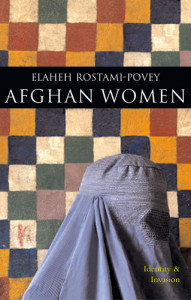|
Reviewed by Sara-Jane Chehab, Doctoral Candidate and Instructor, University of Delaware Elaheh Rostami-Povey’s Afghan Women: Identity and Invasion sets out to portray the situation of women in Afghanistan as told by Afghan women themselves. Building on the testimonies of Afghan women in Afghanistan, Pakistan, Iran, the United Kingdom and the United States, Rostami-Povey sheds light over many problems women in patriarchal and war-torn countries grapple with on a daily basis. She shows that unlike what is portrayed in the Western media, Afghan women were never devoid of agentic ability, but have always fiercely challenged the conservative and patriarchal economic and social structures imposed on them by twenty-two years of civil war and the Taliban rule. How have Afghan women overcome the harsh reality that surrounds them? Rostami-Povey demonstrates that Afghan women learned how to face patriarchy, traditionalism, and the lack of security by building social nets and solidarity groups with each other. These networks constituted the primary source for women’s education and empowerment and were kept secret from the Taliban. More importantly, they comprised the only viable organizations upon which the Afghan community could rely. The sense of trust that Afghan women created helped them count on one another and fill a vacuum where economic and social resources were scarce. Even when demands for female labor were low, and despite the fact that agricultural and handicraft were the only sectors in which Afghan women could be employed, the vicious economic circle did not stop Afghan women from being innovative in the kinds of activities they could pursue—such as teaching and tutoring. Rostami-Povey is at her strongest when she argues that what Afghan women need the most is not liberation from conservative and patriarchal traditions, but liberation from the poor material conditions they struggle with every day. Indeed, after the fall of the Taliban, aid associations and development organizations poured into Afghanistan wanting to liberate Afghan women from the burqa, an indicator of female oppression and a remnant of the Taliban-era. For Afghan women, however, this kind of emancipation posed a threat to their cultural identity and to the Afghan family structure which accentuates men’s masculinity and their position as the primary breadwinners. Getting rid of the burqa and engaging in new sorts of economic activities undermined many engrained cultural traditions and led Afghan women to side with their husbands over Western development practitioners. At the top of the list of the unfavorable material conditions cited by Rostami-Povey is security. Even today, the practice of burqa remains prevalent because women do not feel safe to leave home without wearing one. The security situation in Afghanistan—ever worsening since 2004—poses a major threat to women and young girls who wish to get a high school and college education and be active in the labor market. Rostami-Povey believes that the low level of female literacy in Afghanistan is primarily due to security reasons, evidenced by the stories of many women whose parents forbid them to go to school out of fear that they might be kidnapped, raped, or beaten once they leave the domicile. As such, what impedes women from being more active in their society is not Islam or male domination, but a very low level of safety that makes Afghanistan a dangerous country for women. By telling the stories of hundreds of Afghan women living in Afghanistan and the large Afghan diaspora, Rostami-Povey challenges the Western conceptions of Afghanistan and argues that the West has misrepresented women’s oppression by thinking that they were passive actors awaiting liberation from male domination. What Afghan women want is a standing that can preserve men’s masculinity and importance in the family circle. They are not concerned with women’s rights and with achieving an equal standing with men. Afghan women want food, health, security, employment, and education regardless of whether they are considered as lesser citizens in society. Women’s rights and the abolition of patriarchy are of secondary importance to them in comparison to more pressing goals. They are calling for a betterment of their material and economic conditions; for a transformation of the status quo according to Islamic and Afghan values and norms; and for socio-economic development based on providing healthcare, education, and employment. More importantly, Afghan women want to achieve all this according to their own traditions and their own rules. Rostami-Povey gives an illuminating and accurate account of the situation in Afghanistan and of the problems of Afghan women in particular. The strength of Afghan Women as a book is that it encourages readers to leave aside superficial stereotypes and to listen closely to the voices of Afghan women as they tell the world about their plights, their needs, and their hopes, giving the reader a unique window into the current situation in Afghanistan. It leaves the reader hopeful that despite decades of unfair gender positions and austere political and economic circumstances, prospects for sustainable change are reachable. The key to bring about this change is to listen to those who can tell the real story. |


 Afghan Women: Identity and Invasion
Afghan Women: Identity and Invasion